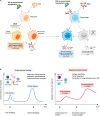Mitigating Coronavirus Induced Dysfunctional Immunity for At-Risk Populations in COVID-19: Trained Immunity, BCG and "New Old Friends"
- PMID: 33013871
- PMCID: PMC7498663
- DOI: 10.3389/fimmu.2020.02059
Mitigating Coronavirus Induced Dysfunctional Immunity for At-Risk Populations in COVID-19: Trained Immunity, BCG and "New Old Friends"
Abstract
The novel, highly contagious coronavirus SARS-CoV-2 spreads rapidly throughout the world, leading to a deadly pandemic of a predominantly respiratory illness called COVID-19. Safe and effective anti-SARS-CoV-2 vaccines are urgently needed. However, emerging immunological observations show hallmarks of significant immunopathological characteristics and dysfunctional immune responses in patients with COVID-19. Combined with existing knowledge about immune responses to other closely related and highly pathogenic coronaviruses, this could forebode significant challenges for vaccine development, including the risk of vaccine failure. Animal data from earlier coronavirus vaccine efforts indicate that elderly people, most at risk from severe COVID-19 disease, could be especially at risk from immunopathologic responses to novel coronavirus vaccines. Bacterial "new old friends" such as Bacille Calmette-Guérin (BCG) or Mycobacterium obuense have the ability to elevate basal systemic levels of type 1 cytokines and immune cells, correlating with increased protection against diverse and unrelated infectious agents, called "trained immunity." Here we describe dysfunctional immune responses induced by coronaviruses, representing potentially difficult to overcome obstacles to safe, effective vaccine development for COVID-19, and outline how trained immunity could help protect high risk populations through immunomodulation with BCG and other "new old friends."
Keywords: BCG; COVID-19; IMM-101; Mycobacterium obuense; SARS; dysfunctional immune response; trained immunity; vaccine.
Copyright © 2020 Kleen, Galdon, MacDonald and Dalgleish.
Figures



Similar articles
-
Could BCG Vaccination Induce Protective Trained Immunity for SARS-CoV-2?Front Immunol. 2020 May 8;11:970. doi: 10.3389/fimmu.2020.00970. eCollection 2020. Front Immunol. 2020. PMID: 32574258 Free PMC article.
-
Potential role of Bacillus Calmette-Guérin (BCG) vaccination in COVID-19 pandemic mortality: Epidemiological and Immunological aspects.Asian Pac J Allergy Immunol. 2020 Sep;38(3):150-161. doi: 10.12932/AP-310520-0863. Asian Pac J Allergy Immunol. 2020. PMID: 32686943 Review.
-
A Systems Biology Workflow for Drug and Vaccine Repurposing: Identifying Small-Molecule BCG Mimics to Reduce or Prevent COVID-19 Mortality.Pharm Res. 2020 Oct 6;37(11):212. doi: 10.1007/s11095-020-02930-9. Pharm Res. 2020. PMID: 33025261 Free PMC article.
-
Biological Rationale for the Repurposing of BCG Vaccine against SARS-CoV-2.J Proteome Res. 2020 Nov 6;19(11):4649-4654. doi: 10.1021/acs.jproteome.0c00410. Epub 2020 Aug 28. J Proteome Res. 2020. PMID: 32794723
-
Progress and Challenges in the Development of COVID-19 Vaccines and Current Understanding of SARS-CoV-2- Specific Immune Responses.J Microbiol Biotechnol. 2020 Aug 28;30(8):1109-1115. doi: 10.4014/jmb.2006.06006. J Microbiol Biotechnol. 2020. PMID: 32627758 Free PMC article. Review.
Cited by
-
Dissemination of COVID-19 in inland cities of Northeastern Brazil.PLoS One. 2021 Jul 9;16(7):e0253171. doi: 10.1371/journal.pone.0253171. eCollection 2021. PLoS One. 2021. PMID: 34242229 Free PMC article.
-
Heterologous vaccination interventions to reduce pandemic morbidity and mortality: Modeling the US winter 2020 COVID-19 wave.Proc Natl Acad Sci U S A. 2022 Jan 18;119(3):e2025448119. doi: 10.1073/pnas.2025448119. Proc Natl Acad Sci U S A. 2022. PMID: 35012976 Free PMC article.
-
Perforin, COVID-19 and a possible pathogenic auto-inflammatory feedback loop.Scand J Immunol. 2021 Nov;94(5):e13102. doi: 10.1111/sji.13102. Epub 2021 Sep 22. Scand J Immunol. 2021. PMID: 34755902 Free PMC article. Review.
-
Rapidly Growing Mycobacterium Species: The Long and Winding Road from Tuberculosis Vaccines to Potent Stress-Resilience Agents.Int J Mol Sci. 2021 Nov 29;22(23):12938. doi: 10.3390/ijms222312938. Int J Mol Sci. 2021. PMID: 34884743 Free PMC article. Review.
-
The Contribution of Human Herpes Viruses to γδ T Cell Mobilisation in Co-Infections.Viruses. 2021 Nov 26;13(12):2372. doi: 10.3390/v13122372. Viruses. 2021. PMID: 34960641 Free PMC article. Review.
References
Publication types
MeSH terms
Substances
LinkOut - more resources
Full Text Sources
Medical
Miscellaneous

